grid_integration_of_renewable_energy_systems
光伏逆变器并网继电器控制方法与流程
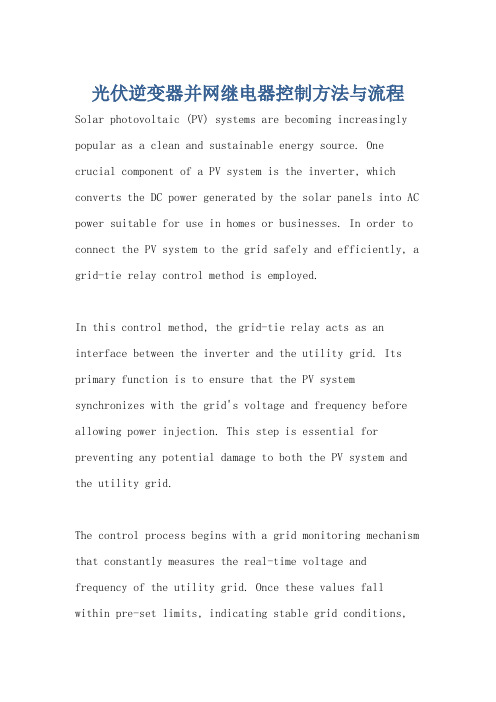
光伏逆变器并网继电器控制方法与流程Solar photovoltaic (PV) systems are becoming increasingly popular as a clean and sustainable energy source. One crucial component of a PV system is the inverter, which converts the DC power generated by the solar panels into AC power suitable for use in homes or businesses. In order to connect the PV system to the grid safely and efficiently, a grid-tie relay control method is employed.In this control method, the grid-tie relay acts as an interface between the inverter and the utility grid. Its primary function is to ensure that the PV system synchronizes with the grid's voltage and frequency before allowing power injection. This step is essential for preventing any potential damage to both the PV system and the utility grid.The control process begins with a grid monitoring mechanism that constantly measures the real-time voltage and frequency of the utility grid. Once these values fallwithin pre-set limits, indicating stable grid conditions,the inverter can start its synchronization process.Upon receiving a command from the control unit, which typically includes information about voltage and frequency thresholds, the inverter initiates its synchronization sequence. It adjusts its output parameters to match those of the utility grid in terms of voltage level, phase angle, and frequency.To ensure accurate power injection into the grid while avoiding sudden fluctuations or overloading, an Anti-Islanding protection mechanism is employed. This safety measure detects any islanding conditions wherein anisolated power source continues supplying electricity to certain loads even after a power outage occurs on the main grid. The grid-tie relay closely monitors this situation and promptly disconnects if an islanding event is detected.After successful synchronization with proper anti-islanding protection measures in place, power injection can commence. The inverter channels electricity generated by solar panels into usable electrical appliances or sells it back toutilities through net metering agreements.It should be noted that there are variations in specific control methods among different types of inverterscurrently available in the market. Some inverters use a more complex control algorithm that includes Maximum Power Point Tracking (MPPT) technology to optimize power conversion efficiency.Overall, the grid-tie relay control method for solar PV systems ensures safe and efficient operation by synchronizing the PV system with the utility grid, preventing islanding conditions, and allowing for proper power injection or export. This method plays a crucial role in enabling the seamless integration of renewable energy sources into existing electrical grids.我的问题是:光伏逆变器并网继电器控制方法与流程太阳能光伏系统作为一种清洁、可持续的能源来源,正变得越来越受欢迎。
未来已来_我们全力以待!——全方位解读IEC白皮书

BETTER COMMUNICATION | GREATER VALUEIEC’s outlookinto the futureBased on an overview of the IEC white papers 未来已来 我们全力以待!——全方位解读IEC白皮书By Vincent Sun 孙加顺IEC is known as the home for industry and the “united nations of technologies” as the organization has been committed to the development of international standards for electric and electronic products, systems and services, collectively known as electrotechnology. Products and systems become increasingly sophisticated when technologies develop faster and faster, for which standards are playing a more vital role and embracing unprecedented challenges.Therefore, it is reasonable for this consensus body not only to solve existing problems in traditional arenas but also to look at the issues of emerging industries and future societies. Gathering leading minds of the industry, IEC has been closely focusing on the development trends of science and technology in a bid to update or develop standards for application of technological results, and the typical observations and prospects are published as white papers.As a form that differs from international standards, white papers together with technology reports at IEC are drafted and developed by the Market Strategy Board (MSB), which as one of the three pillar organs (Standardization Management Board, Market Strategy Board, Conformity Assessment Board) of the organization reports to the Council Board (CB) and identifies the principal technological trends and market needs in the IEC’s fields of activity.Portfolio of the IEC white papersAccording to the IEC, MSB is designated to set strategies to maximize input from primary markets and establish priorities for the technical and conformity assessment work of the IEC, improving its response to the needs of innovative and fast-moving markets. It may establish Special Working Groups (SWGs) under the leadership of a MSB member to investigate certain subjects in depth or to develop a specialized document. So far, the IEC/MSB has officially published 11 white papers and 2 technology reports.Grid integration of large-capacity Renewable Energy sources and use of large-capacity Electrical Energy Storage The Renewable and Sustainable Energy Institute (RASEI) at the University of Colorado at Boulder (CU-Boulder),the National Renewable EnergyLaboratory (NREL),State Grid Corporation of China (SGCC)Coping with the Energy Challenge The MSB Special WorkingGroup on electrical energyefficiency,the leadership of ClaudeBreining from SchneiderElectricEdge intelligence2017the MSB edge intelligenceproject team,Huawei,the Fraunhofer Institute for OpenCommunications Systems FOKUS2017LVDC: electricityfor the 21stcentury2013Nanotechnologyin the sectors ofsolar energy andenergy storage2014Orchestrating infrastructurefor sustainable Smart CitiesThe MSB project team on smartcities,Centre for European PolicyStudies (CEPS)Global energy interconnection2017The MSB global energyinterconnection projest team,the International EnergyAgency (IEA),State Grid Corporation ofChina (SGCC)2014Internet of Things: WirelessSensor NetworksThe MSB wireless sensornetworks project team,the US National Institute ofStandards and Technology (NIST),CTOs of leading internationalorganizationsMicrogrids for disasterpreparedness and recovery2014The MSB project team on microgriddisaster preparedness and recovery,the Commonwealth Scientific andIndustrial Research Organization ofAustralia (CSIRO),the Japanese National Institute ofAdvanced Industrial Science andTechnology (AIST)BETTER COMMUNICATION | GREATER VALUEFrom the above table, we can see that the white papers of the IEC focus around the key working areas of the organization, i.e. electrical energy, power storage and grid technology, future manufacturing and Internet of Things.The first white paper Coping with the Energy Challenge published in 2010 is believed to lay the foundation for the electrical energy efficiency discussion, with a model projecting to address the next 20 years based on the wide array of energy efficiency opportunities and technologies available. It summarizes situations for a roadmap for the international standardization to “enable highest short- and long-term energy efficiency outcomes, today and tomorrow”.This is followed by a series of white papers further road-mapping the technological and standards prospects on the storage, grid and interconnection of electricity. For example, Electrical Energy Storage summarizes “present and future market needs, reviews their technological features, and finally presents recommendations for all EES stakeholders” while the document also provides market guidance for the work of the IEC in support of this industry. Grid integration of large-capacity Renewable Energy sources and use of large-capacity Electrical Energy Storage specifically addresses the increasing presence and influence of renewable energies by looking at the grid integration technologies and difficulties at a global view.Microgrids for disaster preparedness and recovery is actually based on the risk-based mind by “encouraging the operation of microgrids and the implementation of standards to assist disaster relief planning”, to contribute to disaster preparedness and recovery in case of major electricity outage. Strategic asset management of power networks considers the necessity of international standards for power networks since this sector faces a period of profound change for such assets at different levels, ultimately relating to the secure supply of electrical energy. Global energy interconnection discusses the potential of global coordination and balance of electrical energy which can be highly complex and difficult, but fit for the needs of societal development.Other than electricity, the white papers show a natural inclination toward the prospects about the future of industry and infrastructure, which has also been the logical focus of the IEC to keep the system running with technological efficiency. Internet of Things, the future of the physical world, is obviously a priority for the technology circle. IEC publishes two white papers, Internet of Things: Wireless Sensor Networks and IoT 2020: Smart and secure IoT platform, addressing the application of WSNs and next generation platform-level technologies, both involving the discussion of standardization needs and plans. Smartness will be the core of both manufacturing and social operation. That’s why it is so important to employ standards to ensure efficiency and benefits for future cities and factories as highlighted in Orchestrating infrastructure for sustainable Smart Cities and Factory of the future.Contribution of the industryThe IEC family was joined by more than 20,000 experts from leading companies, institutes and organizations from around the globe. The experts not only share the cutting edge technological results and best practices, but also cooperate closely in a systematic and coordinated manner. What they do are also reflected in the development of white papers.Normally, there are projects or special working groups set up in the IEC/MSB for tracking and watching over specific areas of technological development. The white papers are prepared by such technical bodies, yet with enormous support from the industry, institutes and organizations.Those participating minds are ostensibly world-leading in those areas. For example, the Fraunhofer Institute standing for the cutting-edge technologies contributes to the development of Electrical Energy Storage, Factory of the future and Edge intelligence. State Grid Corporation of China (SGCC) standing for the national grid maintainer has provided support in the documentation of Grid integration of large-capacity Renewable Energy sources and use of large-capacity Electrical Energy Storage and Global energy interconnection.Other industry giants like Schneider Electric and Huawei also contribute to the white papers based on their advantages. Experts from national or international organizations have played a vital role in addressing issues concerned in their respective areas. The participation into such cooperation somehow reflects the technological strengths and global influence of different countries or organizations.IEC’s outlook into the futureThe above analysis may shed a light on the prospects of this international organization that the future of industry and society will still have to do with two major pillars, energy and communication, both posing challenges for the infrastructure preparedness.For the future, according to the white papers, the increasing population and expanding urban population will mean more pressure on energy and related infrastructure. Resilience and sustainability will be considered the core principles for the environment of human development. Technology will provide potential paths for addressing existing or emerging issues.Standards are considered the fundamental layer basis for systems. In the system of a factory or even a city, standards play a central role in ensuring the coordination and interoperability. With technology progressing faster, international standards become even more important for the emerging global interconnection. IEC as an international organization possesses the capability and bears the responsibility to contribute to making the world a better place to live.From the white papers, we can see the future through the intelligent prospects of the IEC.Reference:1. https://www.iec.ch/whitepaper2. IEC white papers & technology reports。
光伏电池栅线英语
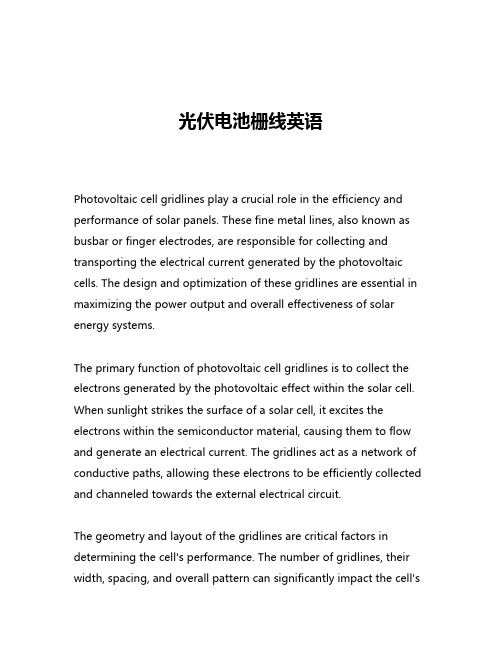
光伏电池栅线英语Photovoltaic cell gridlines play a crucial role in the efficiency and performance of solar panels. These fine metal lines, also known as busbar or finger electrodes, are responsible for collecting and transporting the electrical current generated by the photovoltaic cells. The design and optimization of these gridlines are essential in maximizing the power output and overall effectiveness of solar energy systems.The primary function of photovoltaic cell gridlines is to collect the electrons generated by the photovoltaic effect within the solar cell. When sunlight strikes the surface of a solar cell, it excites the electrons within the semiconductor material, causing them to flow and generate an electrical current. The gridlines act as a network of conductive paths, allowing these electrons to be efficiently collected and channeled towards the external electrical circuit.The geometry and layout of the gridlines are critical factors in determining the cell's performance. The number of gridlines, their width, spacing, and overall pattern can significantly impact the cell'sability to collect and transport the generated current. Optimizing these parameters is a delicate balance between maximizing the conductive area while minimizing the shadowing effect caused by the gridlines themselves.One of the key challenges in designing photovoltaic cell gridlines is to strike a balance between electrical conductivity and optical transparency. The gridlines need to be highly conductive to minimize resistive losses and ensure efficient current collection, but they should also minimize the amount of light they block from reaching the active semiconductor material. This trade-off is often referred to as the "finger shading" problem, where the gridlines can potentially reduce the overall solar cell efficiency if not designed properly.To address this challenge, researchers and engineers have developed various techniques and materials to improve the performance of photovoltaic cell gridlines. One approach is to use thin, narrow gridlines with a high aspect ratio, which can reduce the shadowing effect while maintaining good conductivity. This can be achieved through the use of advanced manufacturing techniques, such as screen printing, inkjet printing, or even laser-based patterning.Another strategy is to explore alternative grid materials and geometries. Instead of traditional metal-based gridlines, some researchers have investigated the use of transparent conductiveoxides (TCOs), such as indium tin oxide (ITO) or aluminum-doped zinc oxide (AZO). These materials can provide good electrical conductivity while allowing more light to pass through the cell, improving the overall efficiency.In addition to the gridline design, the integration of the gridlines with the rest of the solar cell structure is also crucial. The gridlines need to form a reliable and low-resistance contact with the semiconductor material, which can be achieved through careful surface preparation, metallization processes, and the use of appropriate adhesion layers or barrier materials.Furthermore, the durability and reliability of photovoltaic cell gridlines are essential considerations, as they need to withstand the harsh environmental conditions encountered during the lifetime of a solar panel. Factors such as thermal cycling, mechanical stress, humidity, and corrosion can all contribute to the degradation of the gridlines, leading to reduced performance and potential failures. Addressing these reliability challenges through material selection, encapsulation, and packaging design is an active area of research and development in the solar energy industry.As the demand for renewable energy continues to grow, the optimization of photovoltaic cell gridlines has become increasingly important. By improving the design, materials, and integration ofthese critical components, researchers and engineers can contribute to the overall advancement of solar energy technology, making it more efficient, cost-effective, and accessible to a wider range of applications and consumers.In conclusion, photovoltaic cell gridlines are a fundamental element in the performance and efficiency of solar panels. The continuous efforts to optimize their design, materials, and integration within the solar cell structure are crucial in driving the progress of the solar energy industry and contributing to a more sustainable energy future.。
学术综合英语参考答案unit3
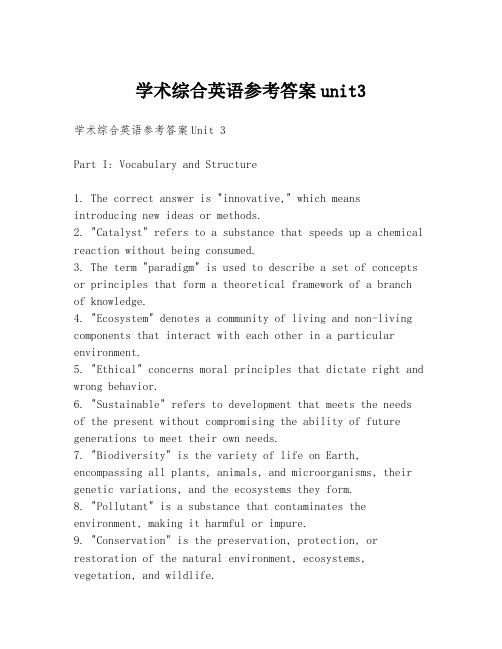
学术综合英语参考答案unit3学术综合英语参考答案Unit 3Part I: Vocabulary and Structure1. The correct answer is "innovative," which means introducing new ideas or methods.2. "Catalyst" refers to a substance that speeds up a chemical reaction without being consumed.3. The term "paradigm" is used to describe a set of concepts or principles that form a theoretical framework of a branch of knowledge.4. "Ecosystem" denotes a community of living and non-living components that interact with each other in a particular environment.5. "Ethical" concerns moral principles that dictate right and wrong behavior.6. "Sustainable" refers to development that meets the needs of the present without compromising the ability of future generations to meet their own needs.7. "Biodiversity" is the variety of life on Earth, encompassing all plants, animals, and microorganisms, their genetic variations, and the ecosystems they form.8. "Pollutant" is a substance that contaminates the environment, making it harmful or impure.9. "Conservation" is the preservation, protection, or restoration of the natural environment, ecosystems, vegetation, and wildlife.10. "Renewable" describes resources that can be replenished naturally and sustainably over time.Part II: Reading ComprehensionA. True or False Questions1. True. The passage states that the use of renewable energy sources can reduce reliance on fossil fuels.2. False. The text mentions that while renewable energy can help reduce greenhouse gas emissions, it does not completely eliminate them.3. True. The passage highlights the importance of researchand development in advancing renewable energy technologies.4. False. The text indicates that while renewable energy is abundant, it can be inconsistent, requiring storage solutions.5. True. The passage discusses the potential for renewable energy to create jobs and stimulate economic growth.B. Multiple Choice Questions1. C. The passage mentions that solar power is a clean and inexhaustible source of energy.2. B. The text explains that wind turbines convert windenergy into electricity.3. A. The passage states that hydroelectric power isgenerated by the movement of water.4. D. The text describes bioenergy as energy derived from organic material.5. E. The passage mentions that geothermal energy is heatfrom the Earth's interior.C. Fill in the Blanks1. photovoltaic cells2. carbon footprint3. intermittency4. energy storage5. grid integrationPart III: Cloze Test1. sustainable2. innovative3. paradigm4. ecosystem5. pollutants6. ethical7. biodiversity8. renewable9. conservation10. catalystPart IV: Writing TaskIn this section, you are asked to write an essay on the topic of "The Importance of Renewable Energy in the 21st Century." Your essay should cover the following points:- The increasing demand for energy and the challenges of relying on fossil fuels.- The benefits of renewable energy sources, such as solar,wind, and hydroelectric power.- The role of technology in advancing renewable energy solutions.- The economic and environmental implications of a transition to renewable energy.- The need for policy support and public awareness to promote the adoption of renewable energy.Sample Essay:The 21st century has ushered in an era of unprecedented energy demand, driven by global population growth and industrialization. Traditional fossil fuels, while abundant, present significant challenges, including environmental degradation and the potential for resource depletion. In contrast, renewable energy sources offer a sustainable alternative that can help mitigate these issues.Renewable energy, derived from the sun, wind, and water, among other sources, is inexhaustible and clean. Solar panels convert sunlight into electricity, wind turbines harness the power of the wind, and hydroelectric dams utilize the force of flowing water. These technologies not only reduce greenhouse gas emissions but also decrease our dependence on finite resources.Advancements in technology have made renewable energy more efficient and cost-effective. Innovations in energy storage and grid integration are addressing the intermittency of renewable sources, making them more reliable and accessible. Furthermore, the transition to renewable energy is aneconomic opportunity, with the potential to create new jobs and stimulate growth in the clean energy sector.However, the shift to renewable energy requires robust policy support and public awareness. Governments must enact incentives for renewable energy development and implement regulations that reduce the environmental impact oftraditional energy sources. Public education campaigns can also play a crucial role in fostering a societal understanding of the benefits of renewable energy and encouraging its adoption.In conclusion, the importance of renewable energy in the 21st century cannot be overstated. As we face the dual challenges of energy scarcity and environmental sustainability, renewable energy offers a promising path forward. With continued innovation, policy support, and public engagement, we can harness the power of the sun, wind, and water to build a cleaner。
绿色能源与可持续发展的英语作文
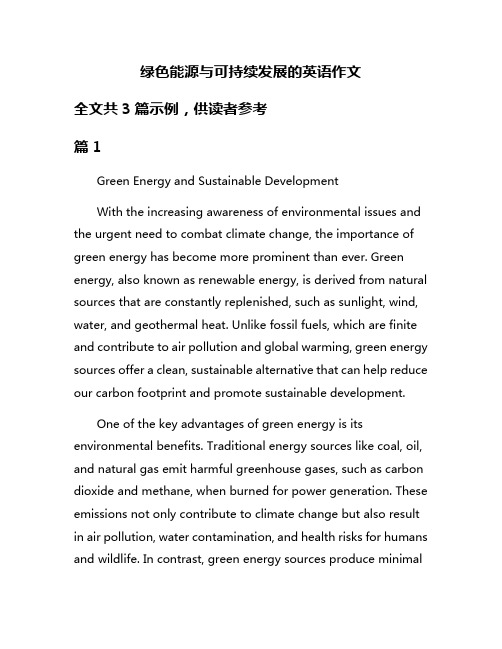
绿色能源与可持续发展的英语作文全文共3篇示例,供读者参考篇1Green Energy and Sustainable DevelopmentWith the increasing awareness of environmental issues and the urgent need to combat climate change, the importance of green energy has become more prominent than ever. Green energy, also known as renewable energy, is derived from natural sources that are constantly replenished, such as sunlight, wind, water, and geothermal heat. Unlike fossil fuels, which are finite and contribute to air pollution and global warming, green energy sources offer a clean, sustainable alternative that can help reduce our carbon footprint and promote sustainable development.One of the key advantages of green energy is its environmental benefits. Traditional energy sources like coal, oil, and natural gas emit harmful greenhouse gases, such as carbon dioxide and methane, when burned for power generation. These emissions not only contribute to climate change but also result in air pollution, water contamination, and health risks for humans and wildlife. In contrast, green energy sources produce minimalto zero emissions, making them a cleaner and more sustainable option for meeting our energy needs.Another advantage of green energy is its potential for economic growth and job creation. As the demand for clean energy technologies continues to rise, so does the need for skilled workers in the renewable energy sector. This presents a significant opportunity for job creation and economic development, particularly in regions that were previously dependent on fossil fuels for energy production. By investing in green energy infrastructure and workforce training, countries can stimulate economic growth, reduce unemployment, and promote a more sustainable and resilient economy.Moreover, green energy can help enhance energy security by diversifying energy sources and reducing reliance on imported fuels. Fossil fuels are often subject to price volatility and geopolitical tensions, which can lead to energy supply disruptions and economic instability. By transitioning to renewable energy sources that are abundant and domestically available, countries can reduce their vulnerability to energy shocks and improve their energy independence. This can also help mitigate the risks associated with fossil fuel extraction and transportation, such as oil spills, gas leaks, and mining accidents.In addition to its environmental, economic, and security benefits, green energy offers a pathway to achieving the United Nations Sustainable Development Goals (SDGs). The SDGs, adopted in 2015, are a set of 17 interlinked goals that aim to address global challenges, such as poverty, inequality, climate change, and environmental degradation. By investing in renewable energy projects and promoting energy efficiency, countries can contribute to multiple SDGs, including affordable and clean energy (SDG 7), decent work and economic growth (SDG 8), climate action (SDG 13), and partnerships for the goals (SDG 17). This integrated approach can help accelerate progress towards a more sustainable and inclusive future for all.Despite these benefits, the transition to green energy is not without challenges. One of the main barriers to widespread adoption of renewable energy technologies is the upfront costs associated with their deployment and infrastructure development. While the long-term benefits of green energy outweigh the initial investment, many governments and businesses struggle to secure financing and overcome regulatory hurdles to support the transition. In addition, the intermittent nature of some renewable energy sources, such as solar and wind power, presents technical challenges for grid integrationand energy storage, which must be addressed through innovative solutions and policy incentives.To overcome these challenges and maximize the potential of green energy, a coordinated effort is needed from governments, businesses, civil society, and the research community. Policymakers can play a key role in setting ambitious clean energy targets, implementing supportive policies and regulations, and providing incentives for renewable energy investment and innovation. Businesses can drive market demand for green energy solutions, develop sustainable business models, and collaborate with stakeholders to achieve shared sustainability goals. Civil society can raise awareness about the benefits of renewable energy, advocate for climate action, and support community-led initiatives to promote clean energy access and affordability. Researchers can contribute to the development of advanced technologies, improve energy efficiency, and inform evidence-based decision-making for a sustainable energy transition.In conclusion, green energy is a vital component of sustainable development and a key solution to addressing the pressing challenges of climate change, environmental degradation, and energy security. By harnessing the power ofrenewable energy sources, we can build a more resilient, inclusive, and prosperous society that meets the needs of current and future generations. Through collective action and shared commitment, we can accelerate the transition to a greener, cleaner, and more sustainable energy future for all. Let us seize this opportunity to embrace green energy and create a brighter, more sustainable world for ourselves and for future generations to come.篇2Green energy, also known as sustainable energy, is the type of energy that is produced from renewable resources that have little to no negative impact on the environment. With the increasing awareness of climate change and the need for sustainability, green energy has become a crucial topic in today's world.One of the major advantages of green energy is that it helps to reduce the amount of greenhouse gases emitted into the atmosphere. Traditional energy sources like coal and oil produce large amounts of carbon dioxide when burned, which contributes to global warming and climate change. Green energy sources such as wind, solar, and hydroelectric power producelittle to no greenhouse gases, making them much more environmentally friendly.Furthermore, green energy helps to reduce our reliance on finite resources such as fossil fuels. As these resources continue to be depleted, the cost of extracting them increases, leading to higher energy prices. By investing in green energy technologies, we can create a more sustainable energy system that is not only better for the environment but also more economical in the long run.In addition to environmental benefits, green energy also has a positive impact on local economies. The development of green energy projects creates jobs in industries such as manufacturing, construction, and maintenance. It also stimulates innovation and research in renewable energy technologies, leading to further advancements in the field.Overall, the transition to green energy is essential for the sustainable development of our society. By investing in renewable energy sources, we can reduce our impact on the environment, create jobs, and secure a more stable and affordable energy future for generations to come. It is up to us to make the switch to green energy and ensure a cleaner and greener world for future generations.篇3Green Energy and Sustainable DevelopmentIn recent years, the push for renewable energy sources has gained momentum as the world grapples with the effects of climate change and the need for sustainable development. Green energy, also known as clean energy, is derived from natural sources that are renewable and environmentally friendly, such as sunlight, wind, water, and biomass. These sources of energy have the potential to reduce carbon emissions, decrease reliance on fossil fuels, and create new economic opportunities.One of the most well-known forms of green energy is solar power. Solar panels harness the energy from the sun and convert it into electricity, providing a clean and renewable source of power. Wind energy is another popular form of green energy, with wind turbines generating electricity by harnessing the power of the wind. Hydroelectric power, derived from water sources such as rivers and dams, is also a key player in the green energy sector. Biomass energy, produced from organic materials such as plants and animal waste, is another renewable energy source that is gaining popularity.The transition to green energy is essential for sustainable development, as it helps reduce greenhouse gas emissions and mitigate the impacts of climate change. It also helps to reduce air and water pollution, protect natural habitats, and promote energy independence. By investing in green energy technologies, countries can create new jobs, stimulate economic growth, and enhance energy security. Furthermore, green energy sources are abundant and widely available, making them a viable long-term solution to our energy needs.Despite the many benefits of green energy, there are still challenges to overcome. The initial costs of installing renewable energy systems can be high, and there are technical and logistical barriers to widespread adoption. Additionally, the intermittent nature of some green energy sources, such as solar and wind power, can pose challenges for grid stability and reliability. However, advancements in technology and policy support are helping to address these challenges and make green energy more accessible and affordable.In conclusion, the shift towards green energy is essential for achieving sustainable development and combating climate change. By embracing renewable energy sources and reducing our reliance on fossil fuels, we can create a more sustainable andprosperous future for generations to come. It is important for governments, businesses, and individuals to work together to accelerate the transition to green energy and build a cleaner, healthier planet for all. With innovation, investment, and collaboration, we can unlock the full potential of green energy and create a more sustainable world for future generations.。
中国新能源可再生英语作文

中国新能源可再生能源的发展与挑战China, as one of the largest economies in the world, has been actively pursuing the path of renewable energy development in recent years. The shift towards renewable energy is not only motivated by the pressing need to mitigate the impact of climate change but also driven by the desire to achieve sustainable economic growth. China's vast landmass and diverse climatic conditions provide a fertile ground for the exploitation of various renewable energy sources, such as solar, wind, and biomass.The solar energy sector in China has witnessed remarkable growth in recent years. The country has invested heavily in solar panel manufacturing and installation, making it a global leader in this field. The widespread use of solar panels in both urban and rural areas has significantly contributed to reducing carbon emissions and promoting clean energy consumption.Wind energy is another area where China has made significant progress. With its vast landmass and coastal areas, the country has ample resources for wind power generation. Wind turbines are being installed in increasingnumbers, particularly in wind-rich regions such as the northwestern provinces. This has not only led to areduction in fossil fuel consumption but has also createdjob opportunities in the renewable energy sector.Biomass energy is another renewable source that China has been actively exploring. The country's agricultural sector produces vast amounts of biomass waste, which can be converted into energy through various techniques. The utilization of biomass energy not only helps to dispose of waste but also reduces dependence on fossil fuels.Despite these significant achievements, China still faces numerous challenges in its renewable energy journey. One of the main challenges is the intermittency of renewable energy sources. Solar and wind power generation, for instance, can be affected by weather conditions,leading to fluctuations in energy supply. This requires the development of effective energy storage systems and grid infrastructure to ensure a stable and reliable power supply. Another challenge is the high initial investment costs associated with renewable energy projects. Although thelong-term benefits of renewable energy are significant, theupfront costs can be prohibitive for many investors. This requires government support and incentives, such as subsidies and tax breaks, to attract private investment and accelerate the deployment of renewable energy projects.Moreover, the integration of renewable energy into the existing power grid is also a complex task. Theintermittent nature of renewable energy sources poses challenges in maintaining grid stability and balancing supply and demand. This requires advanced technologies and intelligent grid management systems to ensure the seamless integration of renewable energy into the power system.In conclusion, China has made significant strides in the development of renewable energy, but there are still numerous challenges to overcome. To achieve its renewable energy goals and contribute to global climate action, China needs to continue investing in research and development, enhancing grid infrastructure, and promoting policies that encourage private investment in renewable energy projects. By addressing these challenges, China can not only secure its energy future but also play a pivotal role in the global transition to a clean and sustainable energy system.**中国新能源可再生能源的发展与挑战**近年来,作为世界上最大的经济体之一,中国一直在积极寻求可再生能源的发展之路。
Renewable Energy Technology Integration
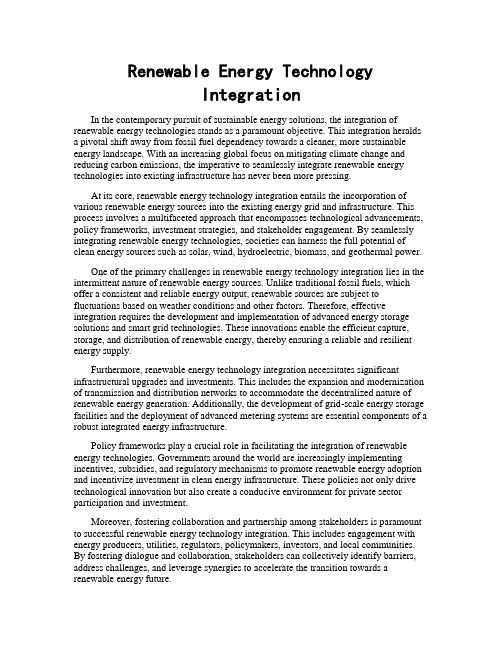
Renewable Energy TechnologyIntegrationIn the contemporary pursuit of sustainable energy solutions, the integration of renewable energy technologies stands as a paramount objective. This integration heralds a pivotal shift away from fossil fuel dependency towards a cleaner, more sustainable energy landscape. With an increasing global focus on mitigating climate change and reducing carbon emissions, the imperative to seamlessly integrate renewable energy technologies into existing infrastructure has never been more pressing.At its core, renewable energy technology integration entails the incorporation of various renewable energy sources into the existing energy grid and infrastructure. This process involves a multifaceted approach that encompasses technological advancements, policy frameworks, investment strategies, and stakeholder engagement. By seamlessly integrating renewable energy technologies, societies can harness the full potential of clean energy sources such as solar, wind, hydroelectric, biomass, and geothermal power.One of the primary challenges in renewable energy technology integration lies in the intermittent nature of renewable energy sources. Unlike traditional fossil fuels, which offer a consistent and reliable energy output, renewable sources are subject to fluctuations based on weather conditions and other factors. Therefore, effective integration requires the development and implementation of advanced energy storage solutions and smart grid technologies. These innovations enable the efficient capture, storage, and distribution of renewable energy, thereby ensuring a reliable and resilient energy supply.Furthermore, renewable energy technology integration necessitates significant infrastructural upgrades and investments. This includes the expansion and modernization of transmission and distribution networks to accommodate the decentralized nature of renewable energy generation. Additionally, the development of grid-scale energy storage facilities and the deployment of advanced metering systems are essential components of a robust integrated energy infrastructure.Policy frameworks play a crucial role in facilitating the integration of renewable energy technologies. Governments around the world are increasingly implementing incentives, subsidies, and regulatory mechanisms to promote renewable energy adoption and incentivize investment in clean energy infrastructure. These policies not only drive technological innovation but also create a conducive environment for private sector participation and investment.Moreover, fostering collaboration and partnership among stakeholders is paramount to successful renewable energy technology integration. This includes engagement with energy producers, utilities, regulators, policymakers, investors, and local communities. By fostering dialogue and collaboration, stakeholders can collectively identify barriers, address challenges, and leverage synergies to accelerate the transition towards a renewable energy future.The benefits of renewable energy technology integration are manifold and extend beyond environmental considerations. By reducing reliance on finite fossil fuel resources, societies can enhance energy security and resilience while mitigating the risks associated with energy price volatility and geopolitical tensions. Furthermore, the widespread adoption of renewable energy technologies stimulates economic growth, fosters innovation, and creates employment opportunities in the burgeoning clean energy sector.In conclusion, renewable energy technology integration represents a pivotal step towards building a sustainable and resilient energy future. Through technological innovation, policy support, and stakeholder collaboration, societies can unlock the full potential of renewable energy sources and transition towards a low-carbon energy paradigm. By embracing renewable energy technology integration, we can pave the way for a cleaner, greener, and more prosperous world for future generations.。
智能电网英语作文

智能电网英语作文In the modern era, the concept of the smart grid has emerged as a transformative technology that promises to revolutionize the energy industry. The smart grid refers to an intelligent network of electricity generation, transmission, distribution, and consumption that utilizes advanced technologies such as sensors, meters, analytics, and automation to improve efficiency, reliability, and sustainability.The need for a smart grid arises from the growing demand for electricity coupled with the challenges posed by aging infrastructure and the integration of renewable energy sources. The traditional grid, with its limited capabilities and inflexible structure, is unable to meet these demands effectively. The smart grid, on the other hand, offers a dynamic and adaptive solution that can handle the complexities of modern energy systems.One of the key features of the smart grid is itsability to collect and analyze data in real-time. This is achieved through the deployment of smart meters and sensors throughout the grid. These devices monitor and transmitinformation about energy usage, demand, and supply,enabling utilities to make informed decisions aboutresource allocation and management. This data-driven approach not only improves operational efficiency but also enhances customer engagement and satisfaction.Another crucial aspect of the smart grid is its interoperability and integration capabilities. Itseamlessly integrates various energy sources, including renewables like solar and wind, with traditional power plants. This integration ensures a more balanced andreliable energy supply, reduces dependence on fossil fuels, and lowers greenhouse gas emissions. Furthermore, the smart grid's ability to connect and communicate with devices and appliances in homes and businesses enables demand response programs that encourage conservation and reduce peak demand. The benefits of the smart grid are numerous. Itimproves the overall efficiency of the energy system, reduces waste and losses, and enhances the reliability of power supply. It also promotes the integration of renewable energy, which is crucial for achieving sustainability and mitigating the impacts of climate change. Additionally, thesmart grid creates new business opportunities and economic growth by enabling innovative services and products in the energy sector.Despite its many advantages, the transition to a smart grid faces some challenges. These include technological complexities, high initial investments, and the need for widespread infrastructure upgrades. However, with continued research and development, as well as government policies and incentives, the smart grid has the potential to become a reality in the near future.In conclusion, the smart grid represents a significant leap forward in the energy industry. It offers a comprehensive solution to address the challenges of aging infrastructure, increasing demand, and the integration of renewable energy sources. By leveraging advanced technologies and data analytics, the smart grid can transform the way we generate, transmit, distribute, and consume electricity, making it more efficient, reliable, and sustainable.**智能电网:能源行业的革命**在现代社会,智能电网作为一项变革性技术,已经崭露头角,有望彻底改变能源行业。
50本电力经典书籍 -回复
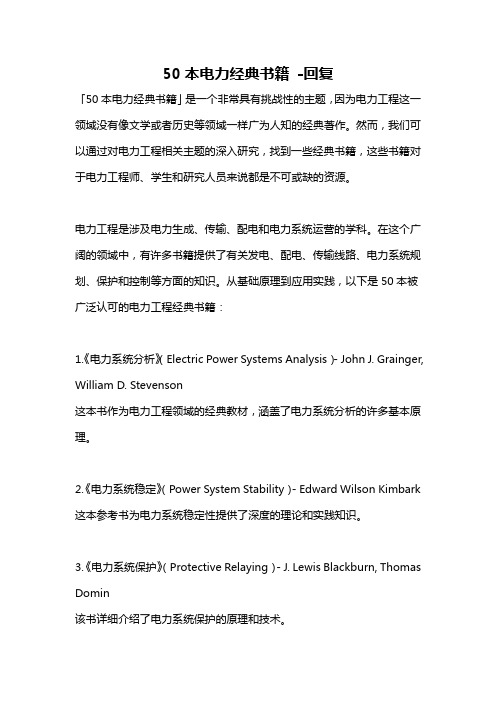
50本电力经典书籍-回复「50本电力经典书籍」是一个非常具有挑战性的主题,因为电力工程这一领域没有像文学或者历史等领域一样广为人知的经典著作。
然而,我们可以通过对电力工程相关主题的深入研究,找到一些经典书籍,这些书籍对于电力工程师、学生和研究人员来说都是不可或缺的资源。
电力工程是涉及电力生成、传输、配电和电力系统运营的学科。
在这个广阔的领域中,有许多书籍提供了有关发电、配电、传输线路、电力系统规划、保护和控制等方面的知识。
从基础原理到应用实践,以下是50本被广泛认可的电力工程经典书籍:1.《电力系统分析》(Electric Power Systems Analysis)- John J. Grainger, William D. Stevenson这本书作为电力工程领域的经典教材,涵盖了电力系统分析的许多基本原理。
2.《电力系统稳定》(Power System Stability)- Edward Wilson Kimbark 这本参考书为电力系统稳定性提供了深度的理论和实践知识。
3.《电力系统保护》(Protective Relaying)- J. Lewis Blackburn, Thomas Domin该书详细介绍了电力系统保护的原理和技术。
4.《电力系统的有功和无功控制》(Active and Reactive Power Control of Electric Power Systems)- Takashi Kaneda该书介绍了有关有功和无功控制的先进方法和技术。
5.《电力电子和电力驱动系统: Fundamentals and Hard-switching Converters》- Bimal K. Bose这本书提供了电力电子和电力驱动系统的基础知识,深入讨论了硬开关变换器。
6.《电离害电、地欠电压与电网故障》(Electromagnetic Transients in Power Systems) - R.D. Begamudre该书详细介绍了电磁暂态现象对电力系统的影响以及如何控制它们。
Renewable Energy Systems
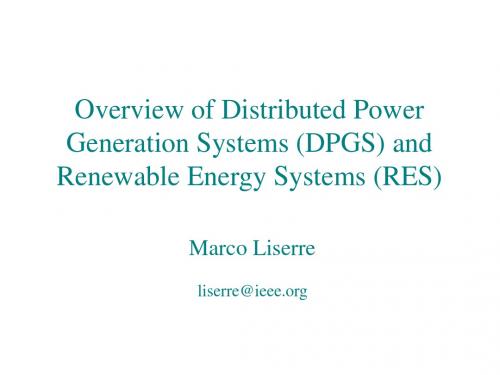
Marco Liserre
liserre@
Overview of Distributed Power Generation Systems (DPGS) and Renewable Energy Systems (RES)
Renewable Energy scenario
In 2007 the world renewable energy production share has been calculated as 19 %.
1985
1990
1995
/kWh) Cost of electricity (¢
1980
40 30 20 10 0
1985
1990
1995
/kWh) Cost of electricity (¢
1980
20
1985
1990
1995
Geothermal
Solar Thermal
15 10
Biomass Electric
In fact countries like China and India require continuously more energy (China energy share increases 1 point every year from 2000).
The need for more energy of the emerging countries and the environmental concerns of USA and EU will drive the increase of the renewable energy production: the importance of renewable energy sources in the future energy scenario is not anymore under discussion ! The needed technology is available and it benefits of continuous improvement due to academic and industrial research activity Knowledge transfer to industry on the basis of international conferences and workshops and educational programs.
中国新能源可再生英语作文
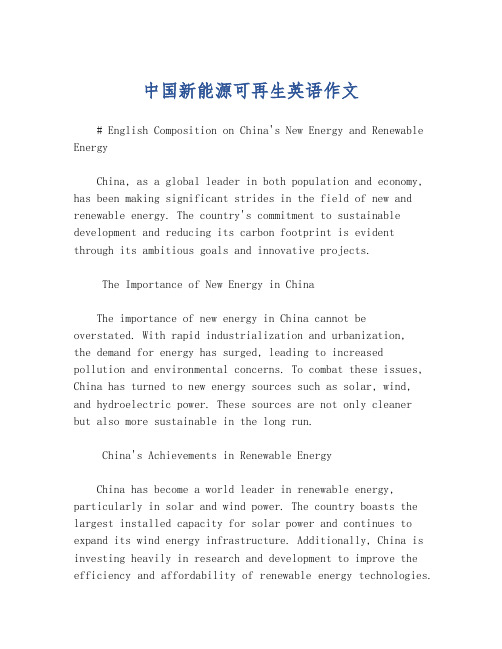
中国新能源可再生英语作文# English Composition on China's New Energy and Renewable EnergyChina, as a global leader in both population and economy, has been making significant strides in the field of new and renewable energy. The country's commitment to sustainable development and reducing its carbon footprint is evident through its ambitious goals and innovative projects.The Importance of New Energy in ChinaThe importance of new energy in China cannot be overstated. With rapid industrialization and urbanization,the demand for energy has surged, leading to increasedpollution and environmental concerns. To combat these issues, China has turned to new energy sources such as solar, wind, and hydroelectric power. These sources are not only cleanerbut also more sustainable in the long run.China's Achievements in Renewable EnergyChina has become a world leader in renewable energy, particularly in solar and wind power. The country boasts the largest installed capacity for solar power and continues to expand its wind energy infrastructure. Additionally, China is investing heavily in research and development to improve the efficiency and affordability of renewable energy technologies.Challenges and Future ProspectsDespite its successes, China faces several challenges in its pursuit of new energy. The integration of renewable energy into the existing grid system, the high costs of some technologies, and the need for consistent government support are all areas that require attention. However, with its strong political will and financial backing, China is well-positioned to overcome these obstacles and continue its leadership in the new energy sector.ConclusionIn conclusion, China's efforts in new and renewable energy are a testament to its commitment to a greener future. As the country continues to innovate and invest in clean energy, it sets an example for the rest of the world to follow. The future of energy is bright, and China is at the forefront of this global transformation.# 中文作文:中国新能源与可再生能源中国,作为全球人口和经济的大国,一直在新能源和可再生能源领域取得显著进展。
房子用电方便吗英文作文
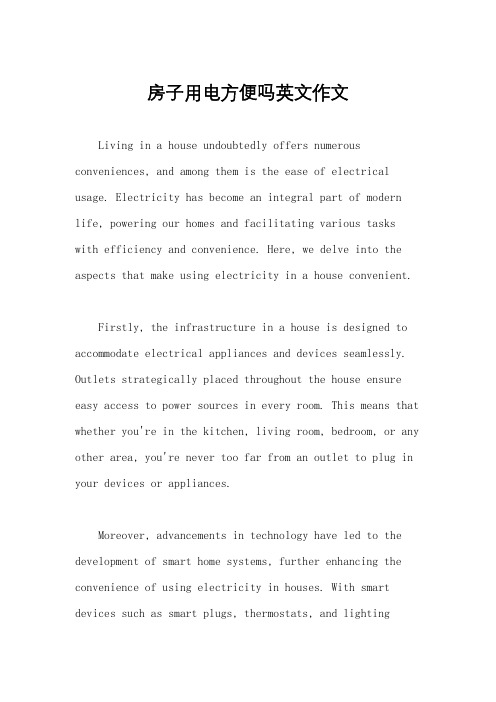
房子用电方便吗英文作文Living in a house undoubtedly offers numerous conveniences, and among them is the ease of electrical usage. Electricity has become an integral part of modern life, powering our homes and facilitating various tasks with efficiency and convenience. Here, we delve into the aspects that make using electricity in a house convenient.Firstly, the infrastructure in a house is designed to accommodate electrical appliances and devices seamlessly. Outlets strategically placed throughout the house ensure easy access to power sources in every room. This means that whether you're in the kitchen, living room, bedroom, or any other area, you're never too far from an outlet to plug in your devices or appliances.Moreover, advancements in technology have led to the development of smart home systems, further enhancing the convenience of using electricity in houses. With smart devices such as smart plugs, thermostats, and lightingsystems, homeowners can control various aspects of their electrical usage remotely through smartphones or voice commands. This level of automation not only adds convenience but also contributes to energy efficiency by allowing users to monitor and adjust their electricity consumption.Another aspect that contributes to the convenience of using electricity in houses is the availability of diverse electrical appliances and gadgets tailored to meetdifferent needs. From kitchen appliances like microwaves, refrigerators, and dishwashers to entertainment devices such as televisions and sound systems, there is a wide range of options to make daily tasks easier and more enjoyable. Additionally, the proliferation of rechargeable devices like smartphones and laptops eliminates the needfor constant battery replacement, further simplifying our reliance on electricity.Furthermore, the reliability of electrical supply in most residential areas adds to the overall convenience of using electricity in houses. With proper infrastructure andmaintenance, power outages are infrequent occurrences, allowing residents to carry out their daily activities without interruption. This reliability is especiallycrucial in emergencies, ensuring that essential services like heating, lighting, and communication remain operational.In addition to indoor convenience, the accessibility of outdoor electrical outlets in houses also offers practical benefits. These outdoor outlets enable homeowners to power tools and equipment for gardening, maintenance, and outdoor leisure activities without the need for extension cords or multiple outlets indoors. Whether it's trimming hedges, mowing the lawn, or setting up outdoor lighting, having electrical access outdoors simplifies these tasks and makes them more efficient.Moreover, the integration of renewable energy sources such as solar panels into residential electrical systems not only provides sustainable power but also contributes to the convenience of using electricity in houses. Homeowners can generate their electricity, reducing dependence on thegrid and potentially lowering utility bills in the long run. Additionally, advancements in energy storage technologyallow excess energy generated during the day to be storedfor use during periods of high demand or low sunlight, ensuring a reliable and uninterrupted power supply.In conclusion, the convenience of using electricity in houses is undeniable, thanks to well-designedinfrastructure, technological innovations, diverse appliances, reliable supply, and the integration of renewable energy sources. With electricity powering our homes, everyday tasks become more manageable, efficient,and enjoyable, enriching our lives in countless ways.。
新能源平价上网英语作文
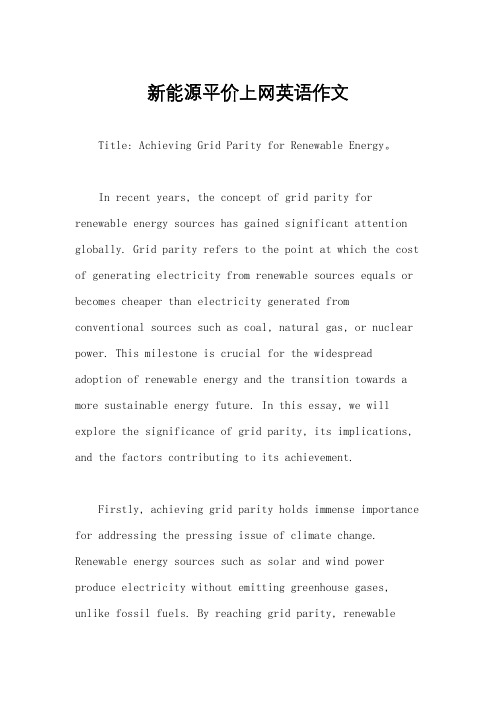
新能源平价上网英语作文Title: Achieving Grid Parity for Renewable Energy。
In recent years, the concept of grid parity for renewable energy sources has gained significant attention globally. Grid parity refers to the point at which the cost of generating electricity from renewable sources equals or becomes cheaper than electricity generated from conventional sources such as coal, natural gas, or nuclear power. This milestone is crucial for the widespread adoption of renewable energy and the transition towards a more sustainable energy future. In this essay, we will explore the significance of grid parity, its implications, and the factors contributing to its achievement.Firstly, achieving grid parity holds immense importance for addressing the pressing issue of climate change. Renewable energy sources such as solar and wind power produce electricity without emitting greenhouse gases, unlike fossil fuels. By reaching grid parity, renewableenergy becomes a more economically viable option, encouraging greater investment and deployment. This, in turn, helps reduce overall greenhouse gas emissions, mitigating the adverse effects of climate change and promoting environmental sustainability.Furthermore, grid parity promotes energy security and independence. Unlike fossil fuels, which are subject to price volatility and geopolitical risks, renewable energy resources are abundant and widely distributed. By harnessing these indigenous sources, countries can reduce their reliance on imported fuels, thereby enhancing energy security. Moreover, grid parity facilitates the decentralization of energy production, empowering communities and reducing vulnerability to disruptions in centralized power grids.The achievement of grid parity also stimulates economic growth and job creation. The renewable energy sector is a significant source of employment, offering opportunities ranging from manufacturing and installation to maintenance and research. As the cost of renewable energy technologiescontinues to decline, investments in these industries can spur economic activity, driving innovation and competitiveness. Additionally, grid parity incentivizes the development of domestic renewable energy markets, reducing dependence on foreign energy imports and fostering economic resilience.Several factors contribute to the attainment of grid parity for renewable energy. Technological advancements play a pivotal role in driving down the costs of renewable energy systems. Innovations in solar photovoltaic (PV) panels, wind turbines, energy storage solutions, and grid integration technologies have significantly improved efficiency and reduced capital costs. Moreover, economies of scale achieved through mass production and deployment further drive cost reductions, making renewable energy increasingly competitive with traditional energy sources.Policy support and regulatory frameworks are also instrumental in accelerating the transition to grid parity. Governments can implement measures such as feed-in tariffs, tax incentives, renewable portfolio standards, and carbonpricing mechanisms to incentivize investment in renewable energy projects and level the playing field with conventional energy sources. Additionally, supportive policies aimed at streamlining permitting processes, facilitating grid access, and promoting research and development can foster innovation and drive down costs across the renewable energy value chain.Public awareness and consumer demand play a crucialrole in shaping the energy landscape. As awareness of environmental issues grows and concerns over climate change intensify, there is increasing demand for clean, sustainable energy solutions. Consumers are becoming more discerning, seeking out products and services that align with their values and contribute to a greener future. This shift in consumer preferences creates market opportunities for renewable energy developers and encourages further investment in grid parity technologies.In conclusion, achieving grid parity for renewable energy represents a significant milestone in the global transition towards a sustainable energy future. By levelingthe playing field between renewable and conventional energy sources, grid parity promotes environmental sustainability, energy security, economic growth, and job creation. Technological innovation, supportive policies, and consumer demand are key drivers in accelerating the attainment of grid parity. As renewable energy continues to become increasingly competitive, it is poised to play a central role in meeting the world's growing energy needs while mitigating the impacts of climate change.。
新能源并网管理流程研究
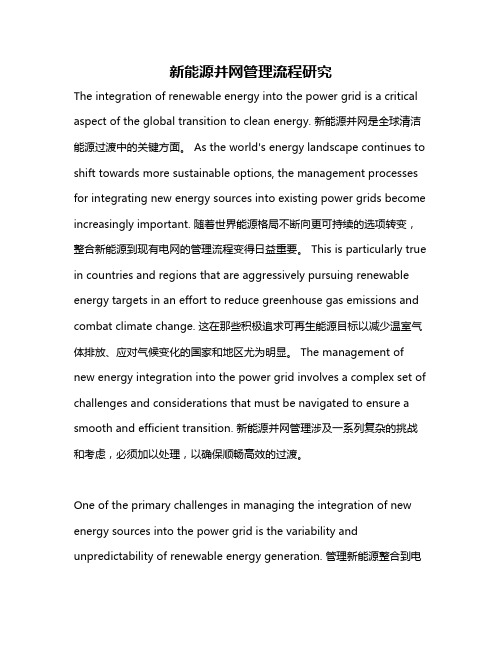
新能源并网管理流程研究The integration of renewable energy into the power grid is a critical aspect of the global transition to clean energy. 新能源并网是全球清洁能源过渡中的关键方面。
As the world's energy landscape continues to shift towards more sustainable options, the management processes for integrating new energy sources into existing power grids become increasingly important. 随着世界能源格局不断向更可持续的选项转变,整合新能源到现有电网的管理流程变得日益重要。
This is particularly true in countries and regions that are aggressively pursuing renewable energy targets in an effort to reduce greenhouse gas emissions and combat climate change. 这在那些积极追求可再生能源目标以减少温室气体排放、应对气候变化的国家和地区尤为明显。
The management of new energy integration into the power grid involves a complex set of challenges and considerations that must be navigated to ensure a smooth and efficient transition. 新能源并网管理涉及一系列复杂的挑战和考虑,必须加以处理,以确保顺畅高效的过渡。
新能源消纳 英语
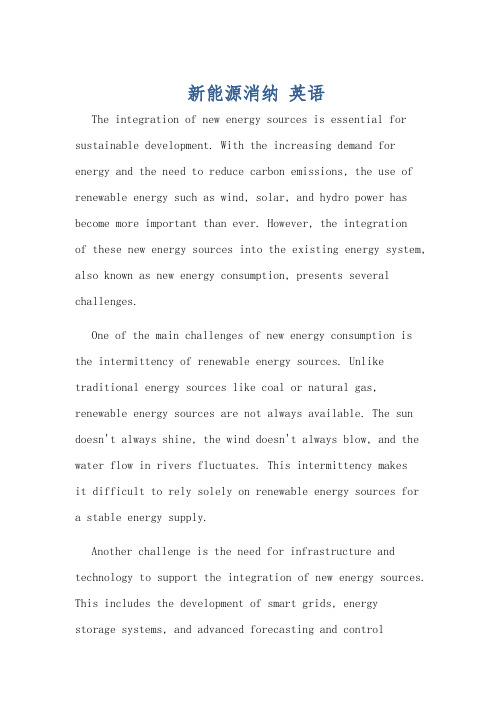
新能源消纳英语The integration of new energy sources is essential for sustainable development. With the increasing demand for energy and the need to reduce carbon emissions, the use of renewable energy such as wind, solar, and hydro power has become more important than ever. However, the integrationof these new energy sources into the existing energy system, also known as new energy consumption, presents several challenges.One of the main challenges of new energy consumption is the intermittency of renewable energy sources. Unlike traditional energy sources like coal or natural gas, renewable energy sources are not always available. The sun doesn't always shine, the wind doesn't always blow, and the water flow in rivers fluctuates. This intermittency makesit difficult to rely solely on renewable energy sources for a stable energy supply.Another challenge is the need for infrastructure and technology to support the integration of new energy sources. This includes the development of smart grids, energystorage systems, and advanced forecasting and controltechnologies. Without these investments, the grid may struggle to handle the variability and unpredictability of renewable energy sources.In addition, the regulatory and market framework needs to be adapted to accommodate the increasing share of renewable energy in the energy mix. This includes the development of appropriate market mechanisms, grid access rules, and policies to incentivize the deployment of renewable energy technologies.Furthermore, the geographical distribution of renewable energy sources may not always align with the demand for energy. For example, wind and solar resources are often located in remote areas, far from the main centers of energy consumption. This requires the development of long-distance transmission lines and grid infrastructure to transport renewable energy from where it is generated to where it is needed.Lastly, public acceptance and awareness of the benefits of new energy consumption are crucial for its successful integration. Community engagement, education, and outreachprograms can help address concerns and build support for renewable energy projects.新能源消纳对可持续发展至关重要。
中学生英文科学演讲稿范文
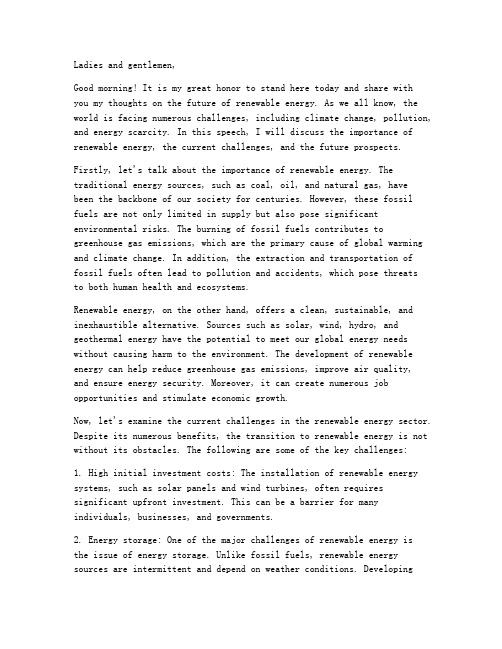
Ladies and gentlemen,Good morning! It is my great honor to stand here today and share withyou my thoughts on the future of renewable energy. As we all know, the world is facing numerous challenges, including climate change, pollution, and energy scarcity. In this speech, I will discuss the importance of renewable energy, the current challenges, and the future prospects.Firstly, let's talk about the importance of renewable energy. The traditional energy sources, such as coal, oil, and natural gas, have been the backbone of our society for centuries. However, these fossil fuels are not only limited in supply but also pose significant environmental risks. The burning of fossil fuels contributes to greenhouse gas emissions, which are the primary cause of global warming and climate change. In addition, the extraction and transportation of fossil fuels often lead to pollution and accidents, which pose threatsto both human health and ecosystems.Renewable energy, on the other hand, offers a clean, sustainable, and inexhaustible alternative. Sources such as solar, wind, hydro, and geothermal energy have the potential to meet our global energy needs without causing harm to the environment. The development of renewable energy can help reduce greenhouse gas emissions, improve air quality,and ensure energy security. Moreover, it can create numerous job opportunities and stimulate economic growth.Now, let's examine the current challenges in the renewable energy sector. Despite its numerous benefits, the transition to renewable energy is not without its obstacles. The following are some of the key challenges:1. High initial investment costs: The installation of renewable energy systems, such as solar panels and wind turbines, often requires significant upfront investment. This can be a barrier for many individuals, businesses, and governments.2. Energy storage: One of the major challenges of renewable energy isthe issue of energy storage. Unlike fossil fuels, renewable energy sources are intermittent and depend on weather conditions. Developingefficient and cost-effective energy storage solutions is crucial for the widespread adoption of renewable energy.3. Grid integration: Integrating renewable energy into existing power grids is another significant challenge. The intermittent nature of renewable energy sources can lead to instability in the grid, necessitating the development of smart grid technologies.4. Public acceptance: The adoption of renewable energy is also influenced by public acceptance. Some people may be concerned about the visual impact of renewable energy installations, such as wind turbines and solar farms, on the landscape.In light of these challenges, what does the future of renewable energy look like? Here are some promising developments:1. Technological advancements: Ongoing research and development in renewable energy technologies are making them more efficient, cost-effective, and reliable. For example, solar panels are becoming more efficient, and wind turbines are producing more power at lower wind speeds.2. Policy support: Governments around the world are increasingly recognizing the importance of renewable energy and implementing policies to promote its development. This includes incentives for renewable energy projects, regulations on emissions, and international agreements to combat climate change.3. Public awareness: As people become more aware of the environmental and health risks associated with fossil fuels, the demand for renewable energy is expected to grow. This will lead to increased investment and innovation in the sector.4. Energy storage solutions: The development of advanced energy storage systems, such as batteries, flywheels, and pumped hydro storage, will play a crucial role in ensuring the stability and reliability of renewable energy systems.In conclusion, the future of renewable energy is bright. With technological advancements, policy support, and public awareness, we can overcome the current challenges and transition to a sustainable, clean energy future. As young people, we have a responsibility to be informed and proactive in promoting the adoption of renewable energy. Let us work together to create a better, more sustainable world for future generations.Thank you for your attention.。
提倡新能源的英语作文
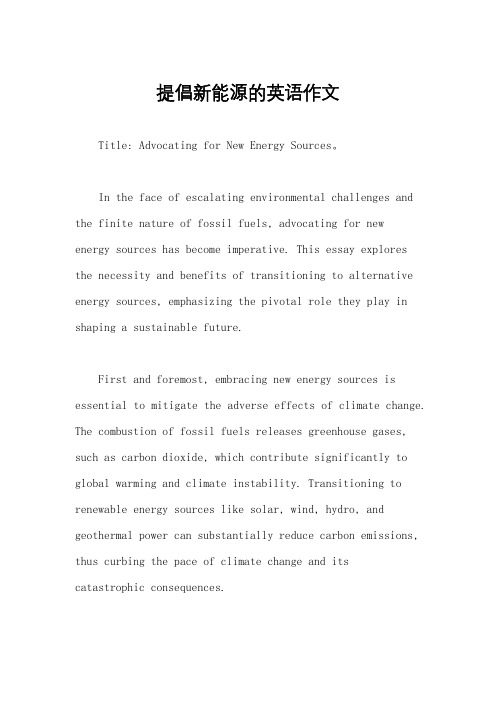
提倡新能源的英语作文Title: Advocating for New Energy Sources。
In the face of escalating environmental challenges and the finite nature of fossil fuels, advocating for newenergy sources has become imperative. This essay explores the necessity and benefits of transitioning to alternative energy sources, emphasizing the pivotal role they play in shaping a sustainable future.First and foremost, embracing new energy sources is essential to mitigate the adverse effects of climate change. The combustion of fossil fuels releases greenhouse gases, such as carbon dioxide, which contribute significantly to global warming and climate instability. Transitioning to renewable energy sources like solar, wind, hydro, and geothermal power can substantially reduce carbon emissions, thus curbing the pace of climate change and itscatastrophic consequences.Moreover, new energy sources offer a pathway to energy independence and security. Unlike fossil fuels, which are subject to geopolitical tensions and price fluctuations, renewable energy can be harnessed locally and is inexhaustible. By investing in renewable energy infrastructure, countries can reduce their dependence on imported fuels, enhance energy resilience, and foster economic growth through job creation and innovation in the clean energy sector.Furthermore, the transition to new energy sources presents significant health benefits. The burning of fossil fuels not only pollutes the air we breathe but also contributes to various respiratory diseases and premature deaths. By phasing out coal-fired power plants and embracing cleaner alternatives, we can improve air quality, safeguard public health, and alleviate the burden on healthcare systems.Additionally, new energy sources offer opportunitiesfor technological advancement and innovation. The rapid growth of renewable energy technologies has spurredbreakthroughs in energy storage, grid integration, and efficiency improvements. These innovations not only enhance the performance and reliability of renewable energy systems but also drive down costs, making clean energy more accessible and affordable for all.Furthermore, transitioning to new energy sources can revitalize rural economies and empower local communities. Renewable energy projects, such as wind farms and solar installations, often require vast expanses of land, providing landowners with lease payments and royalties. Moreover, community-owned renewable energy initiatives empower residents to take control of their energy future, fostering a sense of ownership and pride while generating revenue for local development projects.In conclusion, advocating for new energy sources is not merely an environmental imperative but a moral obligation to future generations. By embracing renewable energy technologies, we can mitigate climate change, enhance energy security, improve public health, foster technological innovation, and empower communities. Asstewards of the planet, it is incumbent upon us to prioritize sustainability and pave the way for a brighter, cleaner, and more equitable future.。
Grid Integration of Renewable Energy
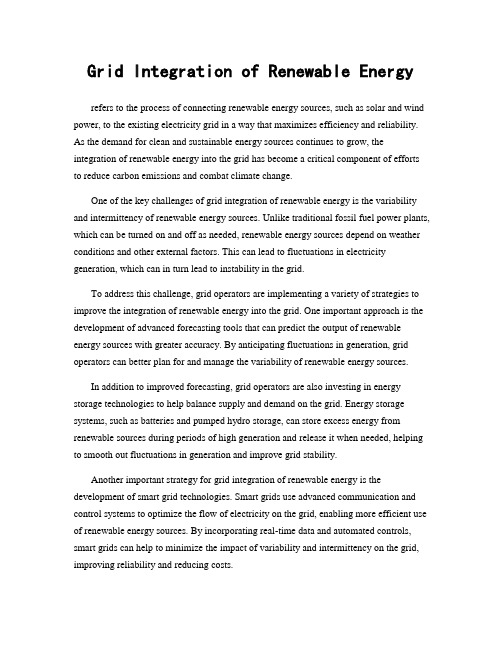
Grid Integration of Renewable Energyrefers to the process of connecting renewable energy sources, such as solar and wind power, to the existing electricity grid in a way that maximizes efficiency and reliability. As the demand for clean and sustainable energy sources continues to grow, the integration of renewable energy into the grid has become a critical component of efforts to reduce carbon emissions and combat climate change.One of the key challenges of grid integration of renewable energy is the variability and intermittency of renewable energy sources. Unlike traditional fossil fuel power plants, which can be turned on and off as needed, renewable energy sources depend on weather conditions and other external factors. This can lead to fluctuations in electricity generation, which can in turn lead to instability in the grid.To address this challenge, grid operators are implementing a variety of strategies to improve the integration of renewable energy into the grid. One important approach is the development of advanced forecasting tools that can predict the output of renewable energy sources with greater accuracy. By anticipating fluctuations in generation, grid operators can better plan for and manage the variability of renewable energy sources.In addition to improved forecasting, grid operators are also investing in energy storage technologies to help balance supply and demand on the grid. Energy storage systems, such as batteries and pumped hydro storage, can store excess energy from renewable sources during periods of high generation and release it when needed, helping to smooth out fluctuations in generation and improve grid stability.Another important strategy for grid integration of renewable energy is the development of smart grid technologies. Smart grids use advanced communication and control systems to optimize the flow of electricity on the grid, enabling more efficient use of renewable energy sources. By incorporating real-time data and automated controls, smart grids can help to minimize the impact of variability and intermittency on the grid, improving reliability and reducing costs.In addition to technical solutions, policy and regulatory frameworks play a crucial role in supporting the integration of renewable energy into the grid. Many countries and regions have implemented policies such as feed-in tariffs, renewable portfolio standards, and carbon pricing mechanisms to incentivize the deployment of renewable energy and ensure a smooth transition to a low-carbon energy system.Overall, grid integration of renewable energy is a complex and multifaceted challenge that requires a combination of technical innovation, policy support, and coordination among stakeholders. By implementing strategies to improve forecasting, invest in energy storage, deploy smart grid technologies, and develop supportive policies, we can ensure a smooth and successful transition to a more sustainable energy future.。
The significance of renewable energy sources
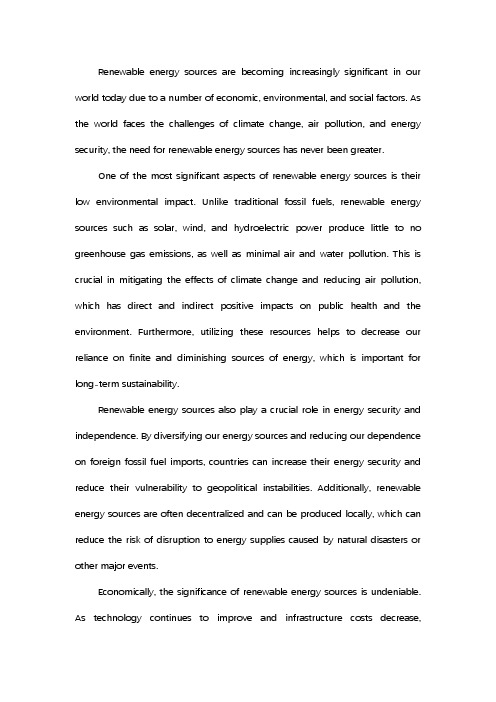
Renewable energy sources are becoming increasingly significant in our world today due to a number of economic, environmental, and social factors. As the world faces the challenges of climate change, air pollution, and energy security, the need for renewable energy sources has never been greater.One of the most significant aspects of renewable energy sources is their low environmental impact. Unlike traditional fossil fuels, renewable energy sources such as solar, wind, and hydroelectric power produce little to no greenhouse gas emissions, as well as minimal air and water pollution. This is crucial in mitigating the effects of climate change and reducing air pollution, which has direct and indirect positive impacts on public health and the environment. Furthermore, utilizing these resources helps to decrease our reliance on finite and diminishing sources of energy, which is important for long-term sustainability.Renewable energy sources also play a crucial role in energy security and independence. By diversifying our energy sources and reducing our dependence on foreign fossil fuel imports, countries can increase their energy security and reduce their vulnerability to geopolitical instabilities. Additionally, renewable energy sources are often decentralized and can be produced locally, which can reduce the risk of disruption to energy supplies caused by natural disasters or other major events.Economically, the significance of renewable energy sources is undeniable. As technology continues to improve and infrastructure costs decrease,renewable energy is becoming more competitive with traditional fossil fuels. This has led to job creation and economic growth in the renewable energy sector, with the potential for further investment and innovation. Furthermore, utilizing renewable energy sources reduces the need for expensive imports of fossil fuels and can help to stabilize energy prices, providing long-term economic benefits.The significance of renewable energy sources extends beyond economic and environmental considerations to social impacts as well. Access to reliable and affordable energy is essential for human development, and renewable energy sources can play a crucial role in providing energy access to those in remote and underserved areas. In addition, the deployment of renewable energy technologies can lead to empowerment and involvement of local communities in energy production, leading to social and economic development.In conclusion, the significance of renewable energy sources cannot be overstated. They offer numerous benefits across economic, environmental, and social dimensions, and play a critical role in addressing the challenges we face in the 21st century. As we strive to transition towards a more sustainable and resilient energy system, the importance of renewable energy sources will only continue to grow. It is essential that we continue to invest in and develop these technologies to ensure a sustainable and prosperous future for generations to come.。
Smart Grid and Energy Storage
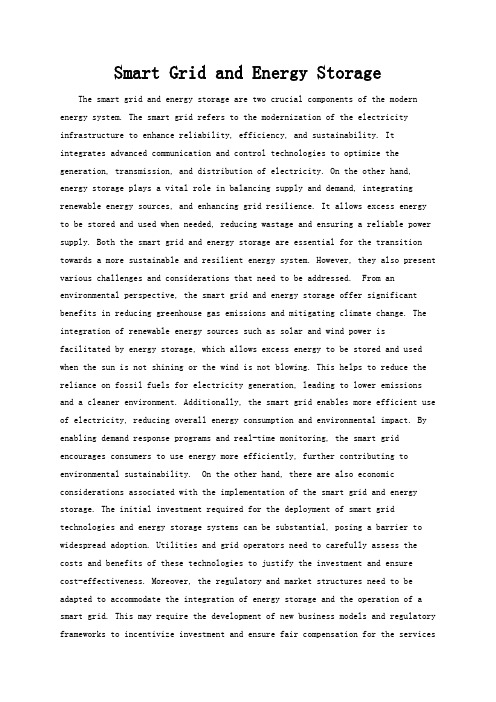
Smart Grid and Energy Storage The smart grid and energy storage are two crucial components of the modern energy system. The smart grid refers to the modernization of the electricity infrastructure to enhance reliability, efficiency, and sustainability. It integrates advanced communication and control technologies to optimize the generation, transmission, and distribution of electricity. On the other hand, energy storage plays a vital role in balancing supply and demand, integrating renewable energy sources, and enhancing grid resilience. It allows excess energy to be stored and used when needed, reducing wastage and ensuring a reliable power supply. Both the smart grid and energy storage are essential for the transition towards a more sustainable and resilient energy system. However, they also present various challenges and considerations that need to be addressed. From an environmental perspective, the smart grid and energy storage offer significant benefits in reducing greenhouse gas emissions and mitigating climate change. The integration of renewable energy sources such as solar and wind power isfacilitated by energy storage, which allows excess energy to be stored and used when the sun is not shining or the wind is not blowing. This helps to reduce the reliance on fossil fuels for electricity generation, leading to lower emissions and a cleaner environment. Additionally, the smart grid enables more efficient use of electricity, reducing overall energy consumption and environmental impact. By enabling demand response programs and real-time monitoring, the smart grid encourages consumers to use energy more efficiently, further contributing to environmental sustainability. On the other hand, there are also economic considerations associated with the implementation of the smart grid and energy storage. The initial investment required for the deployment of smart grid technologies and energy storage systems can be substantial, posing a barrier to widespread adoption. Utilities and grid operators need to carefully assess the costs and benefits of these technologies to justify the investment and ensurecost-effectiveness. Moreover, the regulatory and market structures need to be adapted to accommodate the integration of energy storage and the operation of a smart grid. This may require the development of new business models and regulatory frameworks to incentivize investment and ensure fair compensation for the servicesprovided by energy storage and smart grid technologies. From a technological perspective, the smart grid and energy storage present complex engineering and operational challenges. The integration of diverse energy resources and the coordination of multiple grid components require advanced control and communication systems. Cybersecurity also becomes a critical concern, as the smart grid introduces new vulnerabilities to cyber threats and attacks. Similarly,energy storage technologies need to be reliable, efficient, and cost-effective to be deployed at scale. Research and development efforts are essential to advancethe state-of-the-art in energy storage and smart grid technologies, addressing technical challenges and improving performance and reliability. In addition tothe environmental, economic, and technological considerations, there are alsosocial and regulatory aspects that need to be taken into account. The deploymentof the smart grid and energy storage may raise concerns about privacy and data security, as these technologies rely on the collection and analysis of large amounts of energy usage data. Consumer acceptance and engagement are also crucial for the success of the smart grid, as it requires active participation andbehavior changes from end-users. Furthermore, the regulatory framework needs to evolve to accommodate the integration of energy storage and the operation of a smart grid. This includes addressing issues related to grid interconnection,market participation, and the valuation of grid services provided by energystorage systems. In conclusion, the smart grid and energy storage hold great promise in transforming the energy system towards a more sustainable, reliable,and efficient future. They offer a range of environmental, economic, technological, and social benefits, but also present various challenges and considerations that need to be carefully addressed. Collaboration between industry, government, and research institutions is essential to overcome these challenges and realize thefull potential of the smart grid and energy storage. By working together, we can build a more resilient and sustainable energy system that meets the needs of the present and future generations.。
- 1、下载文档前请自行甄别文档内容的完整性,平台不提供额外的编辑、内容补充、找答案等附加服务。
- 2、"仅部分预览"的文档,不可在线预览部分如存在完整性等问题,可反馈申请退款(可完整预览的文档不适用该条件!)。
- 3、如文档侵犯您的权益,请联系客服反馈,我们会尽快为您处理(人工客服工作时间:9:00-18:30)。
+PVTQFWEVKQP
,QWHJUDWLRQ RI UHQHZDEOH HQHUJ\ LQWR WKH XWLOLW\ JULG FDQ EH DW HLWKHU WKH WUDQVPLVVLRQ OHYHO RU WKH GLVWULEXWLRQ OHYHO GHSHQGLQJ RQ WKH VFDOH RI JHQHUDWLRQ /DUJH UHQHZDEOH HQHUJ\ JHQHUDWLRQ VXFK DV ZLQG IDUPV DUH GLUHFWO\ LQWHUFRQQHFWHG WR WKH WUDQVPLVVLRQ V\VWHP 6PDOO VFDOH GLVWULEXWHG JHQHUDWLRQ LV JHQHUDOO\ LQWHUFRQQHFWHG WR WKH PHGLXP RU ORZ YROWDJH GLVWULEXWLRQ V\VWHPV %RWK W\SHV RI LQWHUFRQQHFWLRQV SUHVHQW GLIIHUHQW FKDOOHQJHV WKDW PXVW EH FDUHIXOO\ DQDO\VHG EHIRUH V\VWHPV DUH GHVLJQHG 7KLV FKDSWHU RXWOLQHV DQG GLVFXVVHV WKH PRVW FRPPRQ LVVXHV HQFRXQWHUHG GXULQJ JULG LQWHJUDWLRQ RI GLIIHUHQW W\SHV RI UHQHZDEOH HQHUJ\ V\VWHPV 7KH DSSOLFDWLRQ RI GHWDLOHG VLPXODWLRQ PHWKRGV WR LGHQWLI\ SUREOHPV DQG WR ILQG VXLWDEOH VROXWLRQV LV DOVR KLJKOLJKWHG )HZ FDVH VWXGLHV DQG VLPXODWLRQ H[DPSOHV DUH SUHVHQWHG WR UHLQIRUFH WKH FRQFHSWV SUHVHQWHG LQ WKH FKDSWHU
4GPGYCDNG 'PGTI[
TXDOLW\ LVVXHV PDNH FRQQHFWLQJ WKHP WKURXJK D SRZHU HOHFWURQLFV LQWHUIDFH D EHWWHU FKRLFH 7DEOH VXPPDUL]HV VRPH RI WKH FRPPRQ W\SHV RI JHQHUDWLRQ DQG WKHLU SUHIHUUHG LQWHUIDFLQJ WHFKQRORJLHV 7\SH )XHO FHOOV :LQG 3KRWRYROWDLFV 6PDOO K\GUR 7DEOH ,QWHUIDFLQJ WHFKQRORJLHV +UUWGU TGNCVGF VQ ITKF KPVGITCVKQP QH UOCNN UECNG IGPGTCVKQP 0RVW HOHFWULF GLVWULEXWLRQ V\VWHPV DUH GHVLJQHG RSHUDWHG DQG SURWHFWHG RQ WKH SUHPLVH RI WKHUH EHLQJ D VLQJOH YROWDJH VRXUFH RQ HDFK GLVWULEXWLRQ IHHGHU ,QWHUFRQQHFWLRQ RI VPDOO VFDOH UHQHZDEOH JHQHUDWLRQ WR WKH GLVWULEXWLRQ JULG YLRODWHV WKLV IXQGDPHQWDO DVVXPSWLRQ 7KHUHIRUH FHUWDLQ VSHFLDO UHTXLUHPHQWV QHHG WR EH VDWLVILHG ZKHQ LQWHUFRQQHFWLQJ GLVWULEXWHG JHQHUDWLRQ WR WKH JULG LQ RUGHU WR HQVXUH VDIH DQG UHOLDEOH RSHUDWLRQ )DXOW FOHDULQJ UHFORVLQJ DQG LQDGYHUWHQW LVODQGHG RSHUDWLRQ DUH PDMRU SURWHFWLRQ UHODWHG FRQFHUQV >,((( @ ,Q PDQ\ FDVHV WKH JULG'* LQWHUIDFH LV EDVHG RQ SRZHU HOHFWURQLFV LQYHUWHUV RU DV\QFKURQRXV JHQHUDWRUV 7KH XWLOLWLHV DUH FRQFHUQHG DERXW WKHLU LPSDFW RQ SRZHU TXDOLW\ 7KH LPSDFWV LQFOXGH KDUPRQLFV YROWDJH GLSV RYHUYROWDJHV DQG YROWDJH IOLFNHU >,((( @ 6HYHUDO VWXGLHV >$OGIHUIHU HW DO 'XJDQ 0F'HUPRWW @ KDYH LGHQWLILHG WKDW WKH WHFKQLFDO UHTXLUHPHQWV LPSRVHG E\ XWLOLWLHV WR DGGUHVV WKHVH FRQFHUQV DV D PDMRU WHFKQLFDO EDUULHU IRU JULG LQWHJUDWLRQ RI '* 7KH VWDQGDUGV VXFK DV ,((( 3 >,((( @ SURYLGH JXLGHOLQHV IRU GHYHORSLQJ WKH JHQHUDO WHFKQLFDO UHTXLUHPHQWV IRU LQWHUFRQQHFWLRQ RI VPDOO VFDOH JHQHUDWLRQ 2TQVGEVKQP KUUWGU 3URWHFWLRQ LV RQH RI WKH PRVW SUREOHPDWLF LVVXHV UHODWHG WR WKH LQWHUFRQQHFWLRQ RI GLVWULEXWHG JHQHUDWLRQ 5DGLDO V\VWHPV DUH WKH PRVW FRPPRQ IRUP RI GLVWULEXWLRQ QHWZRUN FRQILJXUDWLRQ 7KH\ DUH XVXDOO\ SURWHFWHG XVLQJ WLPH JUDGHG RYHUFXUUHQW SURWHFWLRQ VFKHPHV ,QWHUFRQQHFWLRQ RI '*V PD\ DOWHU WKH FRRUGLQDWLRQ RI WKH H[LVWLQJ SURWHFWLRQ VFKHPHV ,I QRW FDUHIXOO\ DGGUHVVHG WKLV FDQ OHDG WR PDOIXQFWLRQ RI SURWHFWLRQ HTXLSPHQW 7KH PDLQ SURWHFWLRQ LVVXHV UHODWHG WR WKH LQWHUFRQQHFWLRQ RI '* DUH EULHIO\ GLVFXVVHG EHORZ D &KDQJH RI 6KRUW &LUFXLW /HYHOV 6KRUW FLUFXLW OHYHO LV RQH RI WKH PDLQ SDUDPHWHUV XVHG LQ WKH VHOHFWLRQ RI FLUFXLW EUHDNHUV UHFORVHUV IXVHV DQG FXUUHQW WUDQVIRUPHUV &7V DQG WKH FRRUGLQDWLRQ EHWZHHQ RYHUFXUUHQW UHOD\V 6KRUW FLUFXLW OHYHO LV FKDUDFWHUL]HG E\ WKH HTXLYDOHQW V\VWHP LPSHGDQFH DW WKH IDXOW SRLQW DQG LQGLFDWHV WKH H[SHFWHG OHYHO RI WKH IDXOW FXUUHQW 7LPH YDULDWLRQ RI WKH IDXOW FXUUHQW LV LQIOXHQFHG E\ WKH FKDUDFWHULVWLFV RI WKH URWDWLQJ PDFKLQHU\ LQ WKH YLFLQLW\ 0RVW GLVWULEXWLRQ V\VWHPV DUH LQLWLDOO\ GHVLJQHG DV SDVVLYH QHWZRUNV ZLWKRXW '* +RZHYHU ZLWK WKH FRQQHFWLRQ RI '* HTXLYDOHQW QHWZRUN LPSHGDQFH FDQ GHFUHDVH UHVXOWLQJ LQ DQ LQFUHDVH LQ WKH IDXOW OHYHO 7KXV LQ FDVH RI D IDXOW WKHUH FDQ EH XQH[SHFWHGO\ KLJK IDXOW FXUUHQWV ,QWHUIDFLQJ WHFKQRORJ\ 3RZHU HOHFWURQLF FRQYHUWHU ,QGXFWLRQ JHQHUDWRUSRZHU HOHFWURQLF FRQYHUWHU G HOHFWURQLF FRQYHUWHU 3RZHU 6\QFKURQRXV RU LQGXFWLRQ HOHFWURQLF FRQYHUWHU JHQHUDWRU SRZHU
+PVGITCVKQP QH UOCNN UECNG IGPGTCVKQP KPVQ FKUVTKDWVKQP ITKFU
(OHFWULFLW\ JHQHUDWLRQ XVLQJ UHQHZDEOH HQHUJ\ UHVRXUFHV LV RIWHQ WDNLQJ SODFH LQ VPDOO VFDOH GXH WR GLVSHUVH QDWXUH RI WKH UHVRXUFHV *RRG H[DPSOHV DUH VPDOO K\GUR VRODU SKRWRYROWDLFV ELRJDV ELRPDVV DQG VPDOO ZLQG WXUELQH EDVHG HOHFWULFLW\ JHQHUDWLRQ V\VWHPV 7KH VL]H RI WKHVH JHQHUDWRUV W\SLFDOO\ YDULHV IURP D IHZ KXQGUHGV RI NLORZDWWV WR VHYHUDO PHJDZDWWV 7KHVH VPDOO VFDOH HOHFWULFLW\ JHQHUDWRUV DUH JHQHUDOO\ FRQQHFWHG WR WKH JULG DW WKH SULPDU\ RU VHFRQGDU\ GLVWULEXWLRQ OHYHO DQG DUH FRQVLGHUHG GLVWULEXWHG JHQHUDWLRQ '* RU GLVWULEXWHG UHVRXUFHV '5 'LVWULEXWHG UHVRXUFHV LQFOXGH ERWK UHQHZDEOH DQG QRQUHQHZDEOH VPDOO VFDOH JHQHUDWLRQ DV ZHOO DV HQHUJ\ VWRUDJH &KHHGTGPV V[RGU QH ITKF KPVGTHCEGU 2IWHQ WKH VPDOO VFDOH UHQHZDEOH JHQHUDWRUV DUH QRW GLUHFWO\ FRQQHFWHG WR WKH JULG 7KH JHQHUDWLRQ WHFKQRORJ\ RU WKH RSHUDWLRQDO FKDUDFWHULVWLFV UHTXLUHV WKH XVH RI VRPH LQWHUIDFH EHWZHHQ WKH JHQHUDWRU DQG WKH XWLOLW\ GLVWULEXWLRQ JULG )RU H[DPSOH VRODU SKRWRYROWDLFV 39 SDQHOV JHQHUDWH GF HOHFWULFLW\ DQG WKHUHIRUH D SRZHU HOHFWURQLFV EDVHG GFWRDF FRQYHUWHU LV UHTXLUHG EHWZHHQ WKH JULG DQG WKH JHQHUDWRU 6RPH WHFKQRORJLHV VXFK DV LQGXFWLRQ JHQHUDWRU EDVHG VPDOO K\GUR RU ZLQG FDQ EH GLUHFWO\ FRQQHFWHG WR WKH DF JULG +RZHYHU FRQFHUQV VXFK DV VWDUWLQJ WUDQVLHQWV HQHUJ\ FRQYHUVLRQ HIILFLHQF\ DQG SRZHU
